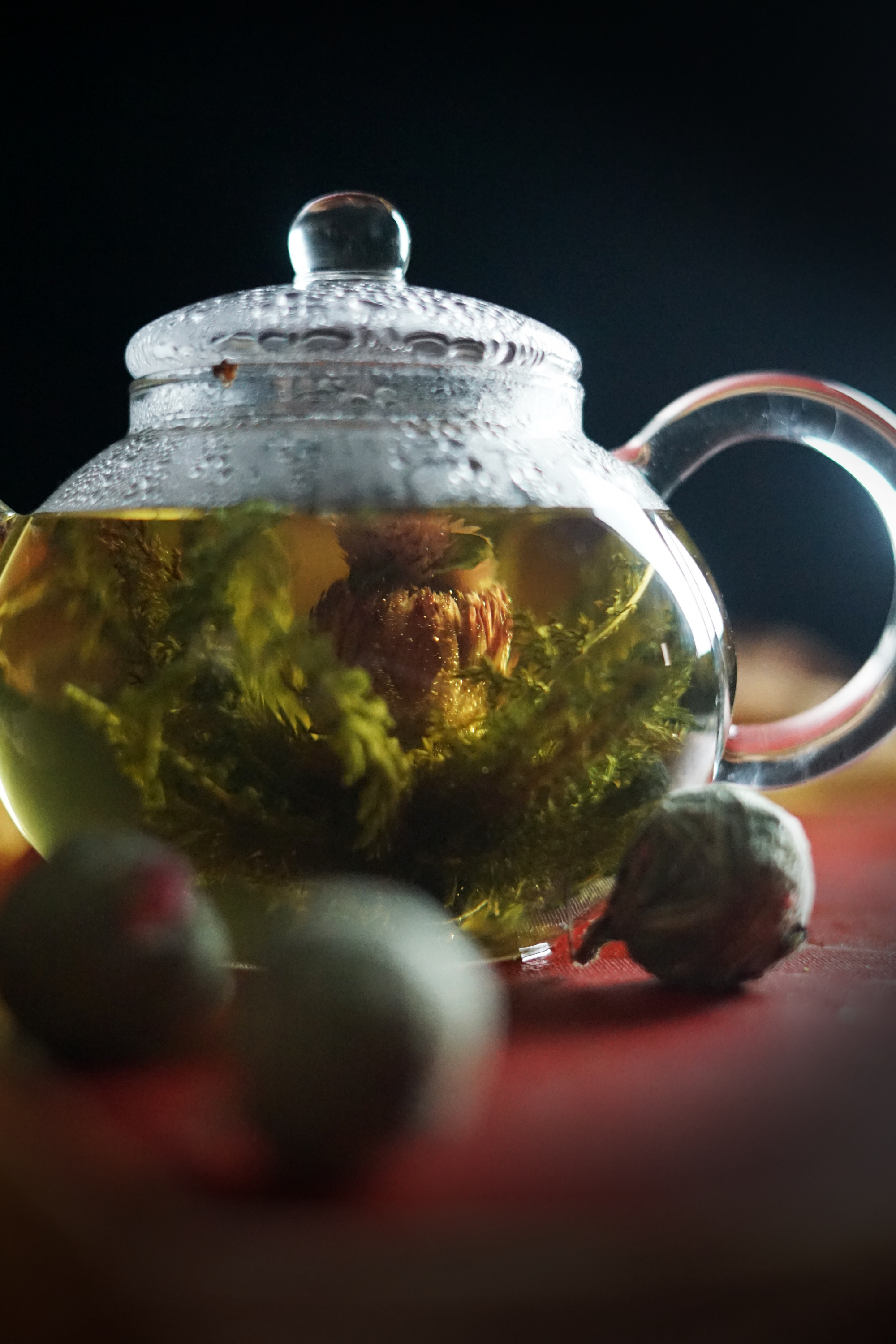Wild Yarrow Blooming Tea and a Protection Ritual
I have long enjoyed “blooming tea,” those special balls you can buy that seem to bloom into a flower in their bath of boiling water. I love the way they unfurl slowly, allowing time for ceremony and community to build around the teapot. A blossom in slow-motion as hearts and conversations open too. What a beautiful symbol and creative presentation!
These handmade blooming tea balls can be purchased at specialty tea shops or Asian markets. They carry exotic flavors of far-away places, of tea plantations on the other side of the world. While that exploration is lovely, I wanted to figure out how to make a tea with locally - foraged flavors that bloomed in the same way, without the caffeine of tea leaves. After a couple of years of experimentation, I’m happy to share my recipe for yarrow blooming tea! This tea has an earthy herbaceousness, accompanied by a pleasant spicy bitterness. It’s wonderful when served with honey.
I have a much more personal connection to yarrow than I do to tea leaves. Yarrow has been a life-long companion to me. I’ve experienced firsthand its antihistamine effects on bee stings, its ability to staunch bleeding, and its soothing effects on menstrual cramps. As a child, I played with the honey-sweet white blossoms and nibbled on the bitter leaves. I’ve used it as a spice, as a medicine, and as a soothing presence in everything from soup to soap.
Yarrow is the first herb I introduce my friends to when taking them foraging for the first time. If there’s one herb I hope they remember, it’s yarrow. Yarrow grows just about everywhere - on every continent except Antarctica, and in both rainforest regions and dry mountain deserts. It’s just as happy at sea level as it is at 7500 feet. It’s especially happy in sandy soils in northern climates. Here in the Pacific Northwest, you can find it growing in the woods, through sidewalks, and likely in your own garden. It’s a handy one to know since it’s so readily available.
It’s also useful in an incredibly diverse number of ways. Yarrow is probably best known for its ability to staunch bleeding, making it an herb revered by knights and soldiers for thousands of years. It’s also known as a strong antihistamine and can be applied as a poultice or taken internally to soothe reactions to bee stings or insect bites. It helps the blood flow more freely and with more balance, countering high blood pressure or heavy and painful menses. It boosts digestion, making your body able to break down more fats. It encourages sweating, effectively lowering fevers or aiding in sauna cleansing. It’s antibacterial and can prevent infection. I could go on and on about yarrow’s historical uses. The gifts that yarrow shares are nearly un-ending, so it’s no surprise that humans have been taking advantage of them for thousands and thousands of years. (Keep in mind, though, that it’s no substitute for modern medicine when it comes to severe wounds or reactions. It can definitely help remove the itchiness of mosquito bites, but it’s not going to stop anaphylaxis brought on by a bee sting in someone who is allergic.)
Yarrow has even been found in the dental remains of a neanderthal from 50,000 years ago. Not only does its usage extend far back in time, it expands outwards, covering the globe. Civilizations from all over the world have used yarrow for all manner of things. According to Native American Ethnobotany by Daniel Moerman, many tribes across the continent used yarrow to heal in a surprising number of ways. All over the world this hardy little plant grows and is loved and named by the cultures who hold it. Its names vary from the Gaelic Earr thalmhuinn (that which clothes the earth) to the Navajo 'Azee'iiltshee'ih (the plant which is dried and used for medicine) to the Chippewa A’djidamo’wano (squirrel tail). Nearly everywhere you travel, you will find yarrow and the people who revere it.
Yarrow, then, is the perfect symbol for connection. Universally recognized by healers and herbalists, it bridges cultures all over the world. Humans have had a relationship with yarrow since the dawn of our time. It is a grandfather herb, a blessing, and a constant. To me, yarrow represents stability, protection, and nourishment. When I drink yarrow tea, I think about ancient civilizations and seeds planted by Gods, of sacred rituals and mysterious blessings. I think about protection.
This is the perfect tea to share with new friends or far-away strangers. It’s a door to discussion about healing and boundaries. Also, it’s beautiful. Try out the recipe, then pair it with the accompanying ritual for an even deeper experience.
Yarrow Blooming Tea
This tea is herbaceous and slightly bitter and spicy. It tastes lovely with honey but can be a bit strong on its own. Yarrow leaves from different environments also carry a wide range of potency; you may find that yarrow foraged in dry mountains tastes much stronger than the verdant versions that grow near the coast. This tea stimulates digestion, soothes menstrual cramps, and gently relaxes the body. It’s not recommended for pregnant or breastfeeding mothers.
For each blooming tea ball, you’ll need:
About 12-15 long yarrow leaves (4” or so)
1 large straw flowerhead
3 flowers from edible gomphrena
Medium ceramic bead
Needle and undyed cotton thread
Cheesecloth or organza fabric
Directions:
Lay the yarrow out in a line in front of you, alternating each leaf to be pointing up or down. Bundle the yarrow together in the middle with a tight knot (using the end of a 1’ length of strong thread with a needle on the other end) so that each side has an even amount of tops vs. stems. Fan the leaves out to from a circle.
Cut the stem off the large strawflower. Carefully run the needle up through the flower, just to the side of the middle. Push it back down through the flower again just on the other side of the middle and run it through the midsection of the yarrow. Very gently pull tight. This should hold the strawflower down on top of the fanned circle of yarrow.
Cut the flowers for the middle down so they are varying heights, from 1-2”. While the needle is below the yarrow bundle, string on a ceramic bead. This will help act as a weight and pull your blooming flower back down into the pot. Run the needle back up through the yarrow bundle and strawflower again, being careful not to split the flower. Run the thread through the bases of the stems to string them together, then put the needle back down through the strawflower and yarrow bundle once more. Tie off and trim the thread. You should now have a yarrow “flower” with a circle of yarrow leaves and a strawflower in the middle with 3 gomphrena sticking out of the top.
Create a little “cup” out of the yarrow circle and loosely tie a piece of thread around it to hold it. Curl the stems of the flowers inward and tuck them into the nest of yarrow. Use your hands to gently pull the yarrow leaves over top to form a ball.. Continue to gently compress and roll the ball with your hands, being careful not to break any of the vegetation.
Tightly wrap the ball in cheesecloth or organza and roll it a bit more to compress it into a small ball. Tie the fabric around the ball tightly. Let dry in a low temperature oven or dehydrator until completely dry, then gently unwrap it.
To serve, place the ball in a clear glass teapot or french press and pour over boiling water. It will slowly unfurl and “bloom” as it steeps. Serve with honey or another sweetener.
Yarrow Tea Ceremony For Boundaries and Protection
You’ll need:
A clear glass teapot
1 blooming yarrow tea ball
Cups for everyone
Honey
Paper and pens
Trusted friends
Directions:
Welcome your guests to your ceremonial space in whatever way feels best to you. Have them take a few moments to get settled in.
Together, breathe deeply and silently 3 times to help get everyone grounded in the present.
Explain that the purpose of this tea ceremony is to allow communication and honesty to bloom and that you will be exploring the theme of safety together.
Place the blooming tea ball in the teapot and pour the boiling water over the top.
Explain that yarrow is associated with boundaries and protection as well as healing and support. Ask each guest to write down something they are seeking protection from, then place the paper under their mug.
As the tea slowly blooms, go around the circle and ask each guest to state and finish this statement “I am opening up about…”
Once the tea blossom has opened up, pour some tea into each guest’s cup.
Ask your guests to notice the smells of the tea and any reactions or messages they experience as they smell it. (You may write your observations down if you’d like.)
Next, have each guest take a small sip. Explain that the bitterness of the tea provides structure and complexity to life; that that same bitterness is the medicine it carries.
Have each guest add honey or sweetener to their tea and continue to taste it.
As you drink your tea, go around the circle and share what you wrote on your paper near the beginning.
Once everyone has had a chance to share, explain the long history of use of yarrow, and that it is an herb beloved by soldiers and cherished for its vitality and strength. Ask your guests to focus on their body and notice the warmth in their stomachs. Ask them to imagine that strength and vitality running through their blood, reaching every part of their body and strengthening it.
Now, have your guests change their phrase from “I seek protection from….” to “I can protect myself from…”. Remind them that they are all stronger than they think, and that they have the support of each other and of yarrow medicine to stay strong and safe. Even if other resources are required to protect themselves from whatever it is that they fear, they are now strong and empowered enough to seek out those resources. Remind them that only they truly know what they need in life and that it is okay to ask for assistance when needed.
Make sure everyone is feeling calm and peaceful again. This may be a good time for more deep breathing, hand-holding, or embracing. A ritual like this can bring up strong emotions, so be prepared to hold space for your guests and show them understanding and compassion.
Finally, thank your guests for opening up, and show gratitude towards yarrow for leading the way. The spent tea can be composted once you remove the ceramic bead, going back to nourishing the earth it came from. Encourage your guests to journal about their experience and be gentle on themselves for the rest of the day.
Love what you’ve read here? Don’t forget to Subscribe to get frequent updates of new posts!
Huge thanks to my Patrons that make sharing all of these lovely posts with you possible (without all of the pop-ups and ads that make browsing other blogs so annoying). If you’re feeling generous, you too can support the wonder with a monthly contribution of your choice. Even $1 helps a lot! Your donation will help to fund this blog as well as my surprise free events and gifts for strangers. Learn more about this program at the link below:
New to foraging? Learn more about ethical and safe foraging (plus how to get started) here!



















Join me for a little winter night magic as we bake this cake full of rich seasonal flavors and black cocoa!